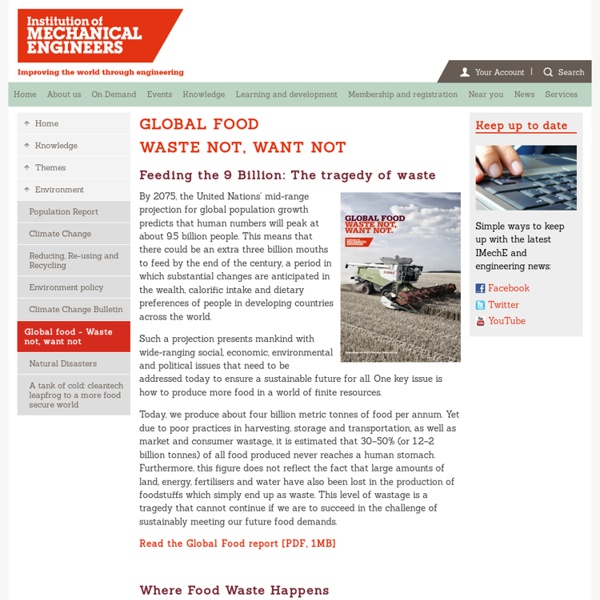Virtual Water - Discover how much WATER we EAT everyday
The good news is that each one of us can also make the world a little more water secure, ready to face the needs of our peak population future. How? The answer lies in our shopping baskets. The amount of meat in our diet is crucial! The average daily water consumption of a meat-eating person is 5000 litres of water per day. The type of meat we consume is crucial! The food we waste is crucial! So, do not forget: one meat-free-day a week choose meat raised on grass do not waste food
Overfilling kettles wastes £68m a year, says report
3 July 2013Last updated at 23:06 ET Some 40% of people boiled water five times a day or more, the study found Three-quarters of British households overfill their kettles, wasting a total of £68m each year, an Energy Saving Trust (EST) report has suggested. The study of 86,000 households also found the average shower lasted seven-and-a-half minutes. A minute less and £215m would be saved, the EST said. Washing clothes at 30C and filling kettles to the required amount were among ways to save money, it added. It said people must not think they were "powerless to control our water use". The EST found British homes collectively used nine billion litres of water a day with showers using a quarter of that and toilets using 22%. Kitchen appliances, such as kettles, dishwashers and washing machines - together with taps - also used 22% of household water, the report said. The study found 95% of people boiled the kettle every day with 40% boiling water five times a day or more. “Start Quote
Kerry McCarthy MP on food waste and FoodCycle
By Kerry McCarthy, MP for Bristol East and FoodCycle Patron In recent years, we have started to see growing recognition of the need to reduce food waste – and to do so in a way which helps to alleviate food poverty. Tristram Stuart’s ground-breaking book, Waste: Uncovering the Global Food Scandal, really lifted the lid on the gratuitous levels of food wasted in the UK and world-wide. Since then, there has – thankfully – been much greater focus on it as an environmental priority. In March 2012, I introduced the first ever piece of legislation to tackle food waste, the Food Waste Bill. A shocking, and unsustainable, 30-50% of all food continues to be wasted, half of which is generated by the food industry. It also feels immoral that good edible food is thrown away when people are going to bed hungry, skipping meals, or can’t afford to give their children a nutritious evening meal. Next year, 2014, has been declared “the European Year of fight against food waste”. Volunteer Donate
Compost Guy | Turning Wastes Into Resources
Raw waste water use on farms is '50% higher' than estimated
Image copyright Nana Kofi Acquah/IWMI The global use of untreated waste water from cities to irrigate crops is much more widespread than previously estimated, says a new report. According to this updated assessment, nearly 30 million hectares are now using untreated water within 40km of an urban centre Some 800 million people, including farmers, vendors and consumers are said to be exposed to serious health risks. China, India, Pakistan, Mexico and Iran account for most of the treated land. The huge populations in big cities across the developing world make very attractive markets for farmers. The lack of refrigeration and transport means that crops need to be grown close to these consumers. Image copyright NEIL PALMER/IWMI "Some might call it sewage, but it's mostly domestic waste water, although it can contain industrial effluent," says study co-author Dr Pay Drechsel, from the International Water Management Institute (IWMI). Image copyright Neil Palmer/IWMI
Our vision & mission - FoodCycle
Vision: At FoodCycle we want a world where communities unite so that no good food is wasted. Come and help us make it happen! Mission: FoodCycle builds communities by combining volunteers, surplus food and spare kitchen spaces to create nutritious meals for people at risk of food poverty and social isolation. We have two programmes that combine surplus food and the energy of our amazing volunteers to create delicious and healthy three-course meals for people in the community. The people we work with and support come from many different walks of life: you can learn more about them here. Hub Programme We run 17 FoodCycle Hubs across the UK. Community Cafe We also run our Pie in the Sky Community Café in Bromley-by-Bow. Could you help support these projects by volunteering or donating? “I come here because I was on the streets for about a month and a half, sleeping on park benches.
Gardeners Sharing Their Harvest With A Community Food Pantry
Home - SAVE FOOD



